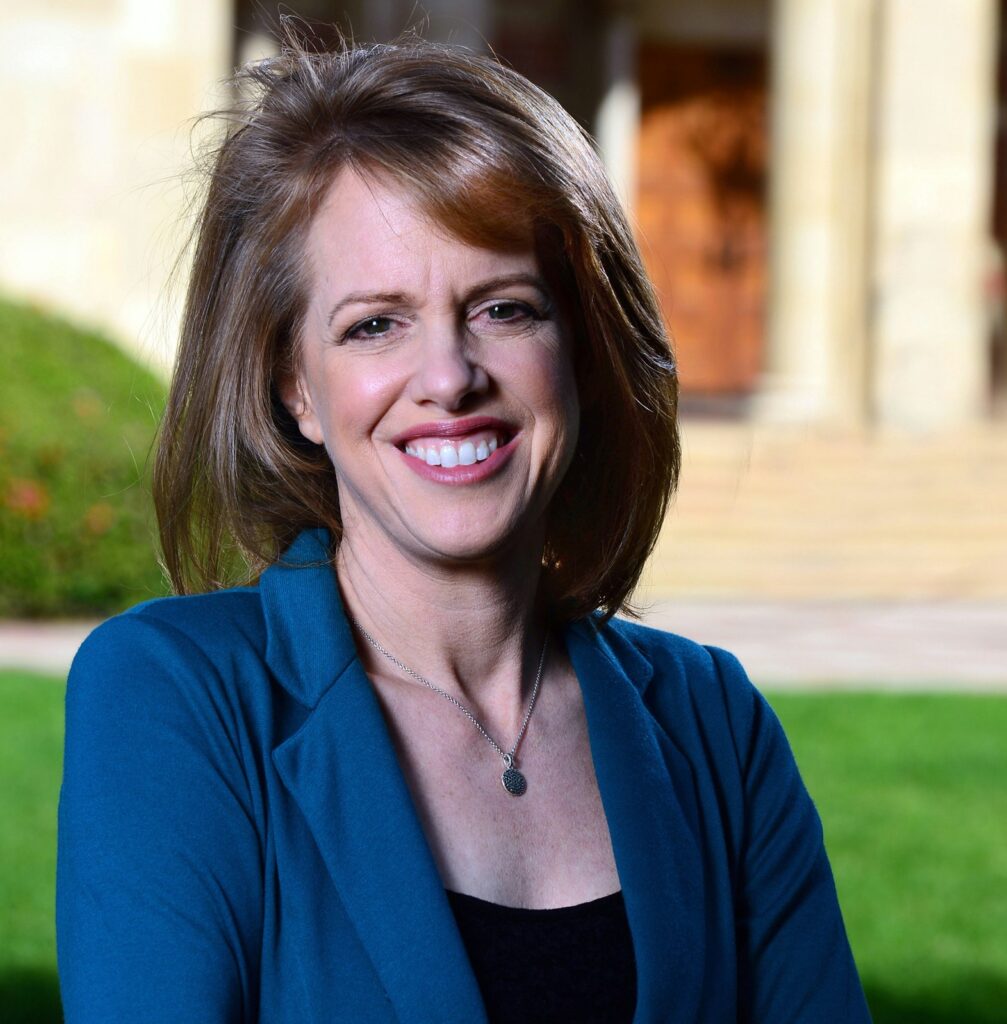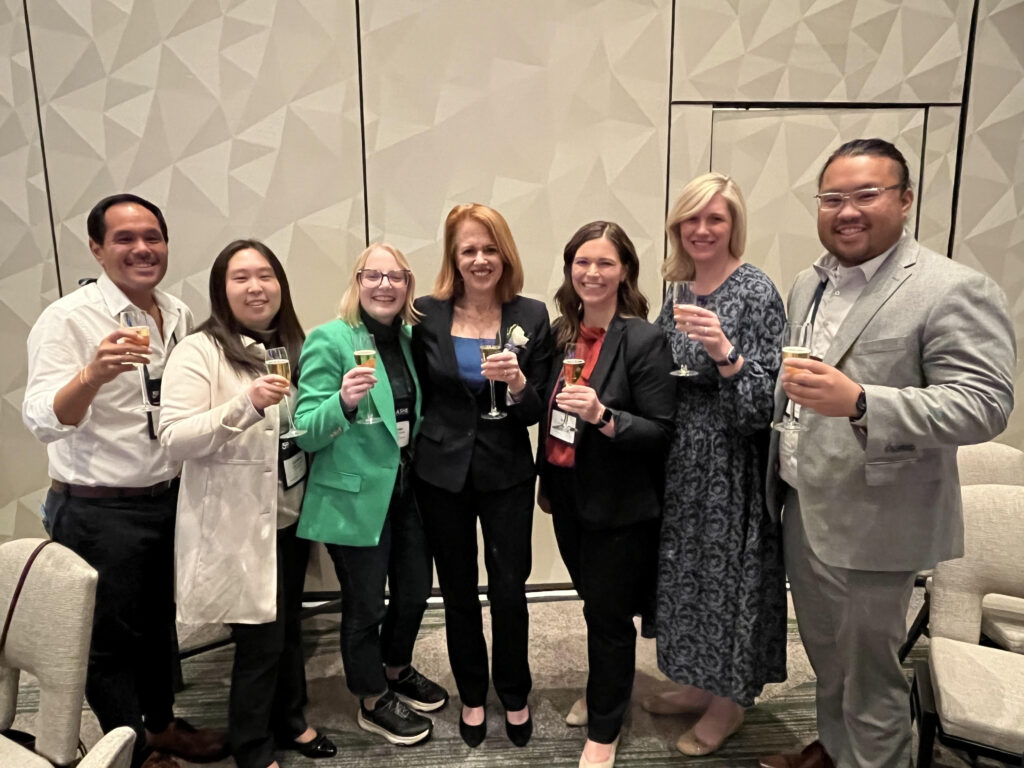*(Author’s note: This article is based in part on “Studying the College Student Experience: Reflections on a Lifetime of Questions,” an essay by UCLA Professor Linda J. Sax published earlier this year in the Journal of The First-Year Experience & Students in Transition, Vol. 37, No. 1)
Recently honored by the Association for the Study of Higher Education in recognition of exemplary achievements and contributions to the study of higher education, Professor Linda Sax work has advanced understanding of college experiences with a focus on gender and race and on equity in the fields of science, technology, engineering, mathematics and computer science. As director of Momentum, she has set new sights on understanding the future of the AI workforce.
Questions, Always Questions.
As an undergraduate student at UC Berkeley, Linda Sax had a lot of questions. As she considered her own college experience, she was trying to understand the ways in which students are affected by college. And as an intern in Washington D.C., digging into data and documenting gender and racial/ethnic disparities in STEM degree attainment using data from the National Center for Education Statistics, she discovered a passion of searching for answers.
Those questions and experiences led her to pursue a career in research, starting in 1990 as a graduate student in higher education at the UCLA School of Education. She never left.
Today, Sax is a professor in the School of Education & Information Studies at UCLA and founding director of Momentum, a UCLA research hub focused on accelerating equity in computing and technology. Her research has resulted in nearly 130 publications, advancing understanding of college experiences with a focus on gender and race, and on equity in the fields of science, technology, engineering, and mathematics. Her work has informed national initiatives, influenced computing and STEM education, and shaped leadership and mentoring practices for diverse scholars. As founder and director of Momentum, she has led the development of a nationally recognized research program examining diversity efforts and seeking to broaden participation in computing, translating rigorous scholarship into actionable policy and practice, including new efforts to understand the future of the artificial intelligence workforce.

This November, Sax was honored by the Association for the Study of Higher Education (ASHE) as the recipient of the 2025 ASHE Research Achievement Award recognizing, “outstanding contribution of a body of research that advances scholars’ understanding of higher education in a significant way.” In announcing the prestigious award, ASHE noted that Sax’s “commitment to inclusive, collaborative research and mentorship of early-career faculty and graduate students have created lasting infrastructure for equity-focused scholarship. Her work demonstrates sustained excellence, impact, and dedication to building research-informed, equitable higher education communities.” A previous recipient of the ASHE Early Career Award (1999) and ASHE Mentorship Award (2019), Sax was also named this year to the inaugural class of ASHE Fellows recognized “for their integrity, advancement of knowledge, mentoring, and service.”
The ASHE Award is meaningful to Sax, a valued recognition from colleagues in an organization that she considers her professional home. And it’s a symbol of the relationships she has developed over her career.
“I feel strongly that the ASHE Award is a reflection of all the people I have worked with. Even if it is in my name, it reflects the contributions of everybody I have worked with or published with over the years, because to me, the research is really all about the people,” says Sax.
While today she is a nationally recognized scholar, the arc of Sax’s learning and scholarship springs from her early research at UCLA, where Sax says she had, “the great fortune” to work with Sandy and Lena Astin who, as leaders of the Higher Education Research Institute (HERI), were exploring the experiences of college students and faculty.

At HERI, Sax had access to the Cooperative Institutional Research Program (CIRP) and its massive databases on college students who had responded to The Freshman Survey and various longitudinal follow-upsurveys.
“I felt like a kid in a candy shop,” says Sax. “I was surrounded by incredible data, wise mentors, and the opportunity to explore questions I deeply cared about.”
Reflecting a maxim of Lena Astin’s that “research is me-search,” Sax’s early work focused on understanding her personal experiences as an undergraduate, experiences that had made her begin to question her own abilities in mathematics and foster feelings of self-doubt she had never felt before. And if that was happening to her, she questioned what impact unsupportive and isolating academic environments were having for other students, especially for women and students of color.
“That focus evolved from when I was younger, because what I experienced was differential treatment on the basis of my gender, and I witnessed others, especially underrepresented students of color, who were also not well represented in these field, impacted in similar ways,” says Sax.
Her first publication focused on mathematical self-concept.
“I wanted to understand whether the self-doubt I began to experience in college was just me or part of a larger problem experienced by women,” she says.
Ultimately, that study affirmed some of Sax’s suspicions about the gender gap in math self-confidence. Women tend to have lower levels of math confidence than men do, and this gap tends to widen during college. It alsohighlighted how impactful the “climate” can be for college students and convinced Sax of the value of disaggregating students (in this case men and women) when conducting research on the impact of college.
A lot of Sax’s early work explored what had been, historically, a focus on how college affects students, which was the trademark of her advisor Sandy Astin. But as she grew as a scholar, she felt that she needed a better understanding of how college affects different students in different ways.
“I felt like it was my place to jump in and take that work and go deeper, to explore how college affects women and men differently, and how it affects students differently on the basis of race or ethnicity or first-generation status or income,” Sax says. “Working with the Astins furthered my core belief that you just can’t assume that college is going to affect all students in the same way. You need data to generate evidence of what it is that’s different, and how and why that is.”
The pursuit of that question, that data, and that evidence has been a driving force in Sax’s career.
“I always have questions, but the truth is, while the process of inquiry is guided by questions, the result is rarely a clear answer. Instead, deep investigation—despite producing data, results, and evidence—ultimately results in a lot more questions,” Sax says. “Yet, rather than feeling disillusioned by that reality, I have come to accept it as the cyclical nature of research.”
Sax has engaged in this cycle now for over three decades, studying the experiences of college students, primarily exploring how college experiences can contribute to more equitable outcomes across student demographics such as gender, race/ethnicity, and socioeconomic background. Much of that work has focused on students within the fields of science, technology, engineering and mathematics, or STEM.
“I think a thread that has appeared in my work across time is a persistent concern about people who are not represented in fields that are important to society and potentially lucrative. I focused on STEM because that had been the case for me,” Sax says. “There are inequities in all aspects of life, but STEM is where I’ve chosen to focus, probably because of my own experience questioning my abilities and sense of fit.”
As she conducted her research on what was happening with students in STEM fields, Sax began to question what was happening with students more broadly in college, in fields beyond STEM.
“I knew I needed to use a wider lens to think about the experiences of women and men in college,” Sax says. “The question that was nagging at me was: Does the college environment affect women and men differently?”
By then, Sax was the nationwide director of the CIRP at UCLA, with access to rich data that would enable her to explore the gender gap at a broad level. She spent much of the early 2000s conducting a nationwide study of the differential effects of college on women and men. To conduct the research, Sax worked closely with what she describes as, “my wonderful team of graduate students” to analyze the CIRP Freshman Survey and four-year follow-up data on approximately 10,000 women and 7,000 men from more than 200 institutions.
The goal was to assess the extent to which college environments and experiences exert similar or dissimilar effects on women’s and men’s college outcomes. What they learned is that among the literally hundreds of significant relationships between college environments and student outcomes, nearly three-quarters (73%) represented effects of college that were dissimilar for women and men. Sax’s research was published as a book, “The Gender Gap in College: Maximizing the Developmental Potential of Women and Men.”
Sax’s research would also delve into the role played by students’ interactions with faculty and family. Previous work had shown that that men’s and women’s interactions with faculty produced somewhat different outcomes. Her data shed light on how women and men are influenced by the quantity as well as the quality of their interactions with college faculty.
“It was becoming evident from my and others’ research that more student–facultyinteraction isn’t necessarily better,” Sax says. “We needed to pay greater attention to the nature and quality of the interaction.”
As a parent at that time of two school age children, Sax also began to focus in greater depth on students’ interactions with their parents. Sax collaborated on an initial study showing that most parents were not behaving in a hovering or “helicopter” manner. While they communicated with their children fairly frequently, they generally did not do so in a manner that students considered to be intrusive or encroaching on their independent decision-making. The study also found significant differences based on gender, race, social class, and parent immigration status.
“That study confirmed my belief that we simply could not talk about the role of parents without also considering students’ demographic backgrounds,” Sax said.
That work led to the development of a data bank related to student–parent engagement included in an existing longitudinal survey of more than 1,000 first-year college students. Those studies provided evidence that the frequency of the interaction between students and parents cannot be used as a proxy for the quality or impact of the interaction and that there were gender and/or race-based differences in the outcomes associated with students’ interactions with their parents.
As time passed, Sax was growing increasingly aware that the gender gap in STEM had remained a persistent challenge in higher education and began thinking about returning to what had been an original focus of her research.
“In the 1990s, I thought we were making such forward progress in society that these issues were not going to be as relevant in five to 10 years. I really believed that. I thought we were headed towards the closing of the gap,” Sax says. “But 15 years later, I returned to this work going, huh? What is happening here? I looked back at the Freshman Survey data, and the gaps were actually at least as large in math confidence and in the representation women and people of color in STEM fields. That convinced me to return to a focus on STEM.”
As she returned her attention toward students in STEM, Sax grew increasingly interested in what was happening in the field of computer science, which seemed to be the field most stubborn in its resistance to change. She spent the summer of 2014 thinking about how she could do more to both understand and address equity gaps in the computing field.
That led to a project with Maria Klawe, then-president of Harvey Mudd College, who was seeking a researcher to undertake a major study of diversity in computer science. It turned out to be a career-shaping opportunity. The project was called BRAID (Building, Recruiting, and Inclusion for Diversity), a partnership with the Anita Borg Institute (now known as AnitaB.org), that involved 15 universities across the United States that had committed themselves to diversifying their undergraduate computer science programs. Sax’s role was to lead a study exploring what BRAID departments were doing to diversify their computing programs, the impacts on students exposed to such efforts, and how all of this contributed to diversifying computing.
The research on BRAID became the focus of Sax’s work for several years and eventually led to the formation of Momentum: Accelerating Equity in Computing and Technology, a UCLA research program Sax founded and has led since 2019. Sax and her colleagues (in particular, Kathleen Lehman and Chantra Nhien) have trained a team of senior researchers, postdoctoral scholars, graduate student researchers, and undergraduate interns that works collaboratively to address questions aimed at informing efforts to improve the recruitment, retention, and support of groups that have been historically marginalized in computing education and technology pathways.

Building from BRAID, Momentum expanded to engage in new collaborations with organizations and funding partners to broaden participation in computing and has developed a public access database to a comprehensive repository of recently published (2005 – 2023) scholarly articles that advance knowledge around broadening participation in undergraduate computing (BPC) in the United States.
“We have this rich database that can help us identify what has been learned empirically about BPC. It’s a big task,” says Sax, “but with new support from Google.org, we’re working on that now, and we’re creating data visualizations and other tools that others can access to understand what the research has found.”
As with many in in the computing field, Sax and her colleagues at Momentum are turning their attention to a consideration of artificial intelligence or AI. As usual, Sax has questions.
“Like computer science broadly speaking, there is a risk that the field of AI will not be representative of all people. Our goal is to help uncover new knowledge about the folks who are developing AI, or who plan to develop AI,” says Sax. “It’s about raising questions about who will develop our future AI technologies. What is their training, what are their backgrounds, what are their ethics and values? Should we be concerned about it? We have collected the data, but we need to analyze it, and we are currently seeking funding to do that.”
The Momentum team has been conducting a longitudinal multi-institutional study that tracks the experiences and outcomes of thousands of undergraduates who enrolled in computing courses at 16 universities participating in Northeastern University’s Center for Inclusive Computing initiative to improve access to computing education. The just-completed survey highlights students’ post-college experiences and adds a new focus on students’ engagement with AI.
The survey explores students’ understanding of and attitudes toward AI, asking questions such as whether they think it’s harmful or beneficial and exploring concerns about misuse and misinformation, bias in algorithms, the invasion of privacy, loss of social connection, and their confidence in their abilities to use and develop AI technologies.
“At a very basic level, we can already see significant concerns about aspects of AI among students who take computing courses, and more so among women than men,” Sax says. “So again, we see significant gender gaps in a critical aspect of the computing field.”
“It’s a rich data set, but we need the time, resources, and people to really dig into it and analyze the findings. I’m hoping to identify funding to support Momentum to analyze the data and report on these findings. I think there’s a ton to learn here.”
Sax also has her sights set on sharing the Momentum datasets with other scholars so that even more can be learned from data. “My longer-term goal is to bring people together and play a mentoring role with scholars around the country who are interested in engaging with our data to further understand what colleges can do to broaden access to computing.”
Mentorship has always been central to Sax’s work. “Personally, I love the mentoring aspect of my job. Mentoring junior scholars is something I enjoy very much and want to do more of. I feel like I’ve learned so much about managing research teams in what I hope is a humane and respectful way, and I learn so much from my team. That’s the kind of community and culture I try to create at Momentum, and I would love to share that with others.”
“When I think about the purpose of my work, it’s about the two things: empowering people and discovery. I love getting the light bulb to go on for students, I love helping people understand research concepts that they didn’t think they could understand, or that they didn’t think were relevant. I’ve always been motivated by teaching as a vehicle for empowerment.”
“As for discovery, it is in my bones, I have lots of questions, and every time I get inspired by a question, I think, what would I need to do to answer that question?” says Sax. “I am always trying to figure out what questions to ask, what kinds of data to collect, how better to conduct my analyses, and how to interpret what I’ve found. The discovery part is best when it involves people, because there’s no way I would want to do all this completely by myself, and I never have. People are a huge part of what I do and why I love what I do.”
